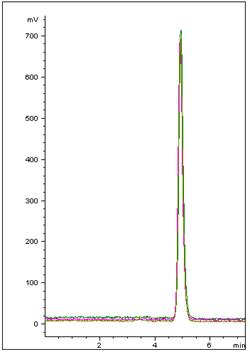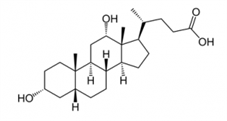Deoxycholic Acid Analyzed with ELSD- AppNote
August 24, 2021
/
/
/
/
/
An Analysis of a Bile Acid
Column: Cogent UDC Cholesterol™, 4μm, 100Å
Catalog No.: 69069-15P
Dimensions: 4.6mm x 150mm
Mobile Phase: 90:10 Methanol / DI Water with 0.1% Formic Acid-
Injection vol.: 5μL
Flow rate: 0.5mL / minute
Detection: ELSD (Evaporative Light Scattering Detector) Gain: 9; Temperature: 55°C;
Sample Preparation: Deoxycholic Acid standard solution 1.0mg / mL in Methanol
Note: Deoxycholic Acid is a a secondary bile acid is a metabolic byproduct of intestinal bacteria. It is used in various fields of human medicine, mainly for emulsification of fats for absorption in the intestine. The acid is also used as a biological detergent to lyse cells, and for isolation of membrane associated proteins.

This simple Method shows excellent Peak shape and Reproducibility as shown in the five injection overlay below.
As the shape of the molecule is very similar to steroids, the Cogent UDC-Cholesterol™ Column was selected for this Method as it is founded on the ability to retain compounds based on shape, hydrophobicity, and polarity of molecules.
Peak:
Deoxycholic Acid
Column: Cogent UDC Cholesterol™, 4μm, 100Å
Catalog No.: 69069-15P
Dimensions: 4.6mm x 150mm
Mobile Phase: 90:10 Methanol / DI Water with 0.1% Formic Acid-
Injection vol.: 5μL
Flow rate: 0.5mL / minute
Detection: ELSD (Evaporative Light Scattering Detector) Gain: 9; Temperature: 55°C;
Sample Preparation: Deoxycholic Acid standard solution 1.0mg / mL in Methanol
Note: Deoxycholic Acid is a a secondary bile acid is a metabolic byproduct of intestinal bacteria. It is used in various fields of human medicine, mainly for emulsification of fats for absorption in the intestine. The acid is also used as a biological detergent to lyse cells, and for isolation of membrane associated proteins.



